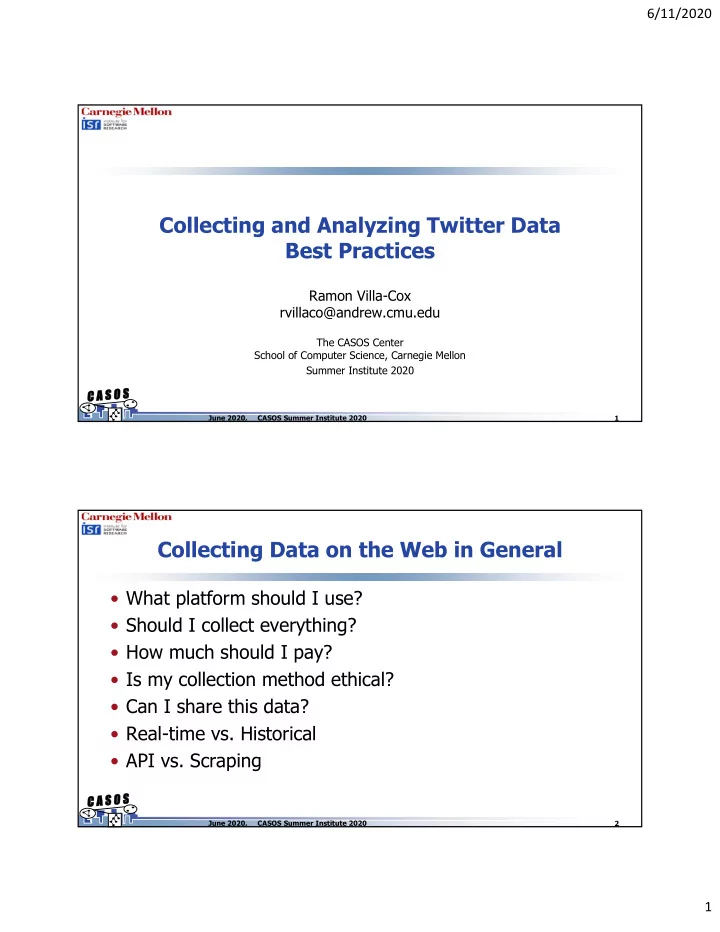

6/11/2020 Collecting and Analyzing Twitter Data Best Practices Ramon Villa-Cox rvillaco@andrew.cmu.edu The CASOS Center School of Computer Science, Carnegie Mellon Summer Institute 2020 June 2020, CASOS Summer Institute 2020 1 Collecting Data on the Web in General • What platform should I use? • Should I collect everything? • How much should I pay? • Is my collection method ethical? • Can I share this data? • Real-time vs. Historical • API vs. Scraping June 2020, CASOS Summer Institute 2020 2 1
6/11/2020 Why Twitter? • One popular social website---more users, more data • Various ways to collect data---depends on your research purpose. • Easy to collect, though there are certain limitations to share the data. June 2020, CASOS Summer Institute 2020 3 Ways to Collect Twitter Data • Following users • Following keywords Streaming API Yes • Following locations(geo-bounding boxes) • Real-time? • Sampling tweets without filters • Get follower ids No Search by users • Get followee ids (certain rate limits) • Get user timeline June 2020, CASOS Summer Institute 2020 4 2
6/11/2020 What format is my data in • JSON! • Related question, what is it? • JSON is a simple format for sharing unstructured data • Typically – one JSON “object” per tweet/line of file June 2020, CASOS Summer Institute 2020 5 Tweets to meta-networks Networks Twitter JSON Structure • Text • User x User • Coordinates – Mention • Created_at – Following • favorite_count – Retweet • favorited • Hashtag Graphs • id • Lang – Co-occurrence • User (another JSON object) – Bipartite graph: user x hash tag • … • Node attributes – Profile features: following count, creation Full list of fields at: date,… https://dev.twitter.com/overview/api/tweets – Language patterns, geo coord., etc June 2020, CASOS Summer Institute 2020 6 3
6/11/2020 How to do it? • Option 1: Use some commercial data collecting services • Option 2: Get the ASU team to do it (TweetTracker) • Option 3: Do it yourself! – What you’ll need: • API credentials (https://apps.twitter.com/) • Find a programming language you’re comfortable with – R - twitteR package – Python – tweepy is the most popular tool – Java – Hosebird is Twitter’s own tool for connecting to the streaming API June 2020, CASOS Summer Institute 2020 7 Common approaches • Track all tweets within the U.S. for 6 months • Follow 1000 users I think are interesting for 6 months, do a network analysis • Follow #coronavirus for 6 months, do a network analysis • … June 2020, CASOS Summer Institute 2020 8 4
6/11/2020 Common practice 1 1. Hook in to the Streaming API with keywords and/or bounding box for a bit 2. Find users that are “interesting” 3. Use the Search API to collect all of these users’ data 4. Try to get rid of bots, celebrities, etc. Pros: Relatively easy, fast Cons: Results are limited to these streaming keywords/locations. The resulting mentioning/retweeting networks are usually sparse. June 2020, CASOS Summer Institute 2020 9 Common practice 2---snowball sampling 1. Start with a set of seed users of interest 2. Collect timelines for these users 3. Find new users within one-step connection (mentioning, following, retweeting) 4. Repeat step 1. Pros: Get comprehensive social links for a group of users. Cons: Time consuming, relies on the choice of seed users. June 2020, CASOS Summer Institute 2020 10 5
6/11/2020 Demo – Step 1: Go to https://apps.twitter.com/, and apply for a developer account. The process can take some days to complete. – Step 2: install tweepy for python, pip install tweepy –user Or (if you use anaconda as a package manager) conda install -c conda-forge tweepy – Step 3: Fill the access token and filtering criteria in stream.py The code takes in a list of strings (queries). Elements in the list are searched as an OR query, words in an element constitute an AND query. – Step 4: run stream.py python stream.py June 2020, CASOS Summer Institute 2020 11 6
Recommend
More recommend